| Article ID | Journal | Published Year | Pages | File Type |
|---|---|---|---|---|
| 6084359 | Injury | 2011 | 7 Pages |
IntroductionTotal hip replacement is increasingly used to treat diseased and damaged joints. With time, some joint replacements may require revision, mainly because of instability and mechanical loosening, and this is of particularly significance to younger patients. A major problem in revision surgery is the loss of bone stock and the consequent difficulty in reconstructing a stable joint. Loss of bone stock has been widely treated using bone autografts and allografts but supplies are limited. Use of bone graft substitutes in combination with, or as a substitute for, human bone is a possible alternative.AimTo identify empirical studies of bone graft substitutes in hip revision surgery.MethodsSystematic review based on Cochrane and MOOSE methods. We searched MEDLINE and EMBASE to December 2010 with terms relating to hip replacement and bone graft substitutes, and checked key citations in ISI Web of Science and reference lists. We considered all human studies irrespective of study design.ResultsSearches identified 397 articles. Screening of abstracts and full text articles identified 7 studies reporting outcomes of bone-graft substitute combined with autograft or allograft, and 6 studies reporting outcomes of bone graft substitute exclusively. One economic evaluation compared costs of femoral head banking with costs of bone graft substitutes. No randomised controlled trials evaluating bone graft substitute effectiveness were identified.Studies generally included small numbers of patients with a follow up too short to assess outcomes relating to implant survival. However, excepting those based on glass ceramic, ceramic bone graft substitutes show promise as an alternative to use of exclusive autograft or allograft. In the case of calcium phosphate ceramic bone graft substitute, potential cost savings were evident.ConclusionWith increased allograft shortage, bone graft substitutes will be required in hip revision surgery. However, appropriately designed randomised controlled trials are required to compare use of existing and new bone graft substitutes with established practice. As well as prosthesis related outcomes, studies should explore the patient experience of revision hip replacement with bone graft substitute material.
